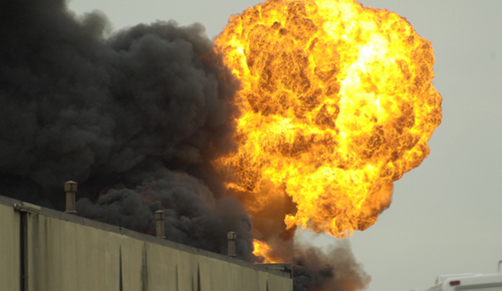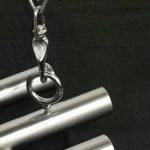The Importance of Dust Explosion Prevention
We know that mitigating the possibility of a dust explosion is a top priority for bulk powder processing plants. Dust explosions not only endanger the health and safety of employees, but can also cause serious facility damage and costly downtime.
While many plants utilize dust collection systems to ensure plant sanitation and help minimize safety risks, powder processors need to be in the know about other components of dust explosion prevention, as well as proactive suppression measures if an explosion does occur.
Below we will explore what dust explosions are, prevention methods and tips, and why a dust explosion suppression system is an important safety component.
What is a Dust Explosion?
Any work with bulk powders can generate dust. But for those working with combustible bulk products, accumulation of combustible dusts is an explosion risk factor.
Simply put, dust explosions occur when the right concentration of combustible particles come into contact with an ignition source. There are five core factors, known as the Dust Explosion Pentagon, that cause dust explosions:
- Combustible dust
- Dispersion
- Oxidizer
- Confinement
- Ignition source
Examples of Dust Explosions
There’s a long history of dust explosions wreaking havoc in industrial environments. One of the earliest recorded dust explosions occurred in 1878 at Minneapolis’ Washburn A Mill, destroying the mill and claiming the lives of 22 employees.
The tragedy led to a number of innovations and safety protocols to prevent dust build up and make workplaces safer. Unfortunately, despite advancements in technology and dust explosion prevention, large-scale explosions still happen today. A few recent dust explosions that made headlines in the United States include explostions at a North Carolina pharmaceutical plant in 2003, a Georgia sugar refinery in 2008, and a Nebraska grain processing facility in 2014.
How to Prevent Dust Explosions
Bin Vents, used to provide high-efficiency dust collection
To mitigate the possibility of a dust explosion, powder processing plants need to keep their facilities as dust free as possible. Dust assessments should be conducted regularly to pinpoint the specific places in production that are vulnerable to dust buildup. Ignition sources should be eliminated whenever possible.
Other dust explosion prevention steps plants can take include:
- Research your bulk powder to determine if it is combustible.
- Install a quality dust collection system that is tailored to the unique needs of your plant and your powder product. At Powder Process-Solutions, all of our systems are designed using the formula Capture, Convey and Collect, to minimize the risk of dust explosions. In addition, consider installing BFM® fitting flexible connectors to provide a dust tight, explosion-resistant seal.
- Use specialized cleaning supplies and only use vacuum cleaners that are approved for Class II conditions.
- If ignition sources are present, use cleaning methods that do not generate dust clouds.
- Control mechanical sparks and friction.
- Separate heating surfaces and heating systems from sources of dust.
- Install dust explosion venting.
Going Beyond Prevention: Dust Explosion Suppression
In addition to the steps outlined above, powder processing plants also need to have dust explosion suppression systems in place. In the event of a dust explosion, a suppression system can help reduce the change of secondary explosions and fires from occurring and causing more damage.
There are two broad types of dust explosion suppression systems that comply with National Fire Protection Association (NFPA) standards for explosion protection: active devices and passive devices.
Passive Suppression Devices
Passive systems react once an event or ignition occurs and responds quickly to suppress the spread of a dust explosion. Two of the most popular models of passive suppression devices are venting systems and passive float valve systems.
- Explosion Venting and Flameless Venting: Explosion venting is designed to minimize an event by allowing the flame to safely exit the system. Flameless venting is an additional venting device that extinguishes the flame that exits the explosion vent. Flameless venting is required for indoor facilities where an exit flame is problematic.
- Passive Float Valve: Installed in the outlet of a dust collection system, passive float valves immediately detect explosive pressure and close a mechanical barrier to contain and extinguish the flame.
Active Suppression Devices
Active systems, which are more complex and expensive than passive devices, anticipate events and act before ignition occurs. Fire isolation systems and fire suppression systems are two of the most popular active suppression devices.
- Fire Isolation: When this system detects a rise in pressure or flames within the ducts, it releases a chemical that stops the spread of explosion by extinguishing the flames.
- Fire Suppression: Fire suppression devices work much like fire isolation systems, except they detect pressure in the dust collection system instead of the ducts. A similar chemical agent is released to suppress the spread of an explosion and flames.
Dust Explosion Suppression System Design
Dust explosions are a significant threat for powder processors that generate combustible dust. Plants need to take steps to both prevent the potential for a dust explosion event, and to suppress an explosion event and minimize the damage.
Powder Process-Solutions has over four decades of experience designing dust collection systems within the food, dairy, and nutritional industries. We specialize in both preventive and active dust explosion suppression systems. We engineer custom solutions based on the unique needs and dynamics of each powder processing plant we serve.
To learn more about the dust explosion prevention and suppression solutions we provide, contact us today.





